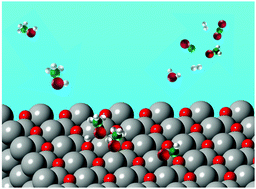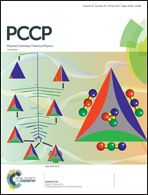Surface chemistry of methanol on different ZnO surfaces studied by vibrational spectroscopy
Abstract
The adsorption and reactions of CH3OH on nonpolar mixed-terminated ZnO(10![[1 with combining macron]](https://www.rsc.org/images/entities/char_0031_0304.gif) 0), polar O–ZnO(000
0), polar O–ZnO(000![[1 with combining macron]](https://www.rsc.org/images/entities/char_0031_0304.gif) ) and Zn–ZnO(0001) surfaces have been studied systematically using high-resolution electron energy loss spectroscopy (HREELS) in conjunction with temperature programmed desorption (TPD). For all three ZnO surfaces, exposure to methanol at room temperature leads to (partially) dissociative adsorption resulting in the formation of hydroxyl and methoxy species. Upon heating to higher temperatures, the dissociated and intact methanol species on ZnO(10
) and Zn–ZnO(0001) surfaces have been studied systematically using high-resolution electron energy loss spectroscopy (HREELS) in conjunction with temperature programmed desorption (TPD). For all three ZnO surfaces, exposure to methanol at room temperature leads to (partially) dissociative adsorption resulting in the formation of hydroxyl and methoxy species. Upon heating to higher temperatures, the dissociated and intact methanol species on ZnO(10![[1 with combining macron]](https://www.rsc.org/images/entities/char_0031_0304.gif) 0) predominantly undergo molecular desorption releasing CH3OH at 370 and 440 K. The Zn–O dimer vacancies are responsible for the decomposition of a small fraction of methanol yielding H2, CH2O and CO at 540 and 565 K. The interaction of methanol with polar O–ZnO and Zn–ZnO surfaces is dominated by thermal decomposition of CH3OH to produce CH2O, H2, CO, CO2 and H2O at elevated temperatures. The high chemical reactivity of both polar surfaces is related to the high abundance of different types of surface defects formed via massive restructuring. Importantly, the reconstructed Zn–ZnO surface exhibits high selectivity for hydrogen production at 520 K, which was not observed for the polar O–ZnO surface. The HREELS data revealed that this low-temperature hydrogen evolution on Zn–ZnO results from methoxy oxidation to a formate species occurring at O-terminated step-edge sites.
0) predominantly undergo molecular desorption releasing CH3OH at 370 and 440 K. The Zn–O dimer vacancies are responsible for the decomposition of a small fraction of methanol yielding H2, CH2O and CO at 540 and 565 K. The interaction of methanol with polar O–ZnO and Zn–ZnO surfaces is dominated by thermal decomposition of CH3OH to produce CH2O, H2, CO, CO2 and H2O at elevated temperatures. The high chemical reactivity of both polar surfaces is related to the high abundance of different types of surface defects formed via massive restructuring. Importantly, the reconstructed Zn–ZnO surface exhibits high selectivity for hydrogen production at 520 K, which was not observed for the polar O–ZnO surface. The HREELS data revealed that this low-temperature hydrogen evolution on Zn–ZnO results from methoxy oxidation to a formate species occurring at O-terminated step-edge sites.



 Please wait while we load your content...
Please wait while we load your content...